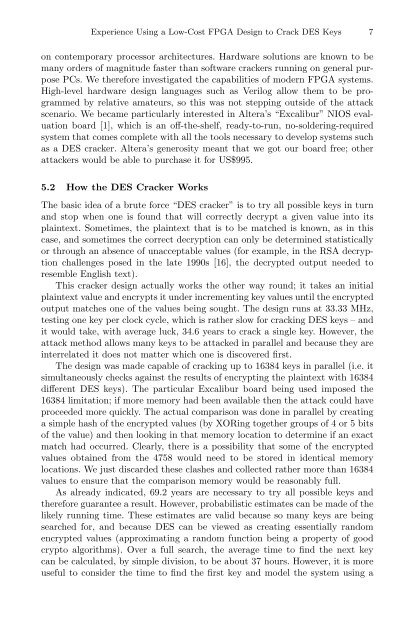Experience Using a Low-Cost FPGA Design to Crack DES Keys
Experience Using a Low-Cost FPGA Design to Crack DES Keys
Experience Using a Low-Cost FPGA Design to Crack DES Keys
You also want an ePaper? Increase the reach of your titles
YUMPU automatically turns print PDFs into web optimized ePapers that Google loves.
<strong>Experience</strong> <strong>Using</strong> a <strong>Low</strong>-<strong>Cost</strong> <strong>FPGA</strong> <strong>Design</strong> <strong>to</strong> <strong>Crack</strong> <strong>DES</strong> <strong>Keys</strong> 7on contemporary processor architectures. Hardware solutions are known <strong>to</strong> bemany orders of magnitude faster than software crackers running on general purposePCs. We therefore investigated the capabilities of modern <strong>FPGA</strong> systems.High-level hardware design languages such as Verilog allow them <strong>to</strong> be programmedby relative amateurs, so this was not stepping outside of the attackscenario. We became particularly interested in Altera’s “Excalibur” NIOS evaluationboard [1], which is an off-the-shelf, ready-<strong>to</strong>-run, no-soldering-requiredsystem that comes complete with all the <strong>to</strong>ols necessary <strong>to</strong> develop systems suchas a <strong>DES</strong> cracker. Altera’s generosity meant that we got our board free; otherattackers would be able <strong>to</strong> purchase it for US$995.5.2 How the <strong>DES</strong> <strong>Crack</strong>er WorksThe basic idea of a brute force “<strong>DES</strong> cracker” is <strong>to</strong> try all possible keys in turnand s<strong>to</strong>p when one is found that will correctly decrypt a given value in<strong>to</strong> itsplaintext. Sometimes, the plaintext that is <strong>to</strong> be matched is known, as in thiscase, and sometimes the correct decryption can only be determined statisticallyor through an absence of unacceptable values (for example, in the RSA decryptionchallenges posed in the late 1990s [16], the decrypted output needed <strong>to</strong>resemble English text).This cracker design actually works the other way round; it takes an initialplaintext value and encrypts it under incrementing key values until the encryptedoutput matches one of the values being sought. The design runs at 33.33 MHz,testing one key per clock cycle, which is rather slow for cracking <strong>DES</strong> keys – andit would take, with average luck, 34.6 years <strong>to</strong> crack a single key. However, theattack method allows many keys <strong>to</strong> be attacked in parallel and because they areinterrelated it does not matter which one is discovered first.The design was made capable of cracking up <strong>to</strong> 16384 keys in parallel (i.e. itsimultaneously checks against the results of encrypting the plaintext with 16384different <strong>DES</strong> keys). The particular Excalibur board being used imposed the16384 limitation; if more memory had been available then the attack could haveproceeded more quickly. The actual comparison was done in parallel by creatinga simple hash of the encrypted values (by XORing <strong>to</strong>gether groups of 4 or 5 bitsof the value) and then looking in that memory location <strong>to</strong> determine if an exactmatch had occurred. Clearly, there is a possibility that some of the encryptedvalues obtained from the 4758 would need <strong>to</strong> be s<strong>to</strong>red in identical memorylocations. We just discarded these clashes and collected rather more than 16384values <strong>to</strong> ensure that the comparison memory would be reasonably full.As already indicated, 69.2 years are necessary <strong>to</strong> try all possible keys andtherefore guarantee a result. However, probabilistic estimates can be made of thelikely running time. These estimates are valid because so many keys are beingsearched for, and because <strong>DES</strong> can be viewed as creating essentially randomencrypted values (approximating a random function being a property of goodcryp<strong>to</strong> algorithms). Over a full search, the average time <strong>to</strong> find the next keycan be calculated, by simple division, <strong>to</strong> be about 37 hours. However, it is moreuseful <strong>to</strong> consider the time <strong>to</strong> find the first key and model the system using a












![Data Structures and Algorithms in Java[1].pdf - Fulvio Frisone](https://img.yumpu.com/30982515/1/190x245/data-structures-and-algorithms-in-java1pdf-fulvio-frisone.jpg?quality=85)
![(Microsoft PowerPoint - Topic 4.ppt [Mode de compatibilit\351])](https://img.yumpu.com/30966934/1/190x245/microsoft-powerpoint-topic-4ppt-mode-de-compatibilit351.jpg?quality=85)

